|
|
 |
|
Calanoida ( Order ) |
|
|
|
Clausocalanoidea ( Superfamily ) |
|
|
|
Diaixidae ( Family ) |
|
|
|
Ranthaxus ( Genus ) |
|
|
| |
Ranthaxus vermiformis Markhaseva & Schulz, 2010 (F) | |
| | | | | | | Ref.: | | | Markhaseva & Schulz, 2010 (p.17, figs.F) | 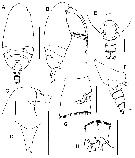 issued from : E.L. Markhaseva & Schulz in Proc. Zool. Inst. RAS, 2010, 314 (1). [p.18, Fig.9]. Female (from 00°01'S, 02°29'W): A-B, habitus (dorsal and lateral, respectively); C, forehead (lateral); D, rostrum (ventral); E, posterior prosome and urosome (dorsal); F, same (lateral); G, genital double-somite (lateral); H, caudal rami (dorsal). Scale bars: A-B = 0.1 mm.; C-H = 0.1 mm. Nota : - Cephalosome and pediger 1 fused, 4th and 5th fused ; posterior corners of prosome prolonged into short points - Prosome 3.8 times as long as urosome. - Rostrum well-developed bifurcate plate with filaments. - Genital double-somite and urosome somites 2 and 3 with fringe of stout spinules along posterior borders . - Caudal rami with 4 terminal plus 1 dorsolateral and ventral setae each, ventral seta located more laterally from medial edge of ramus.
|
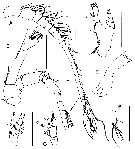 issued from : E.L. Markhaseva & Schulz in Proc. Zool. Inst. RAS, 2010, 314 (1). [p.19, Fig.10]. Female: A, A1; B, same, segment 24 (ancestral segments XXVII-XXVIII); C, A2; D, Md (palp); E, Md (gnathobase); F, P5 (left, dorsal); G, P5 (right, lateral). Scale bars 0.1 mm. Nota: - A1 24-segmented, slightly shorter than prosome. - A2 : coxa with 1 seta ; basis with 2 setae ; endopodal segment 1 with 2 setae ; endopodal segment 2 with 13 setae ; exopod 8-segmented with 1, 3, 1, 1, 1, 1, 1, and 3 setae. Md : gnathobase cutting edge with 8 teeth ; exopod 5-segmented ; endopod 2-segmented ; basis with 4 setae.
|
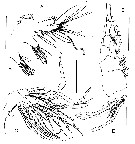 issued from : E.L. Markhaseva & Schulz in Proc. Zool. Inst. RAS, 2010, 314 (1). [p.20, Fig.11]. Female: A, Mx1; B, Mx1 (praecoxal arthrite); C, Mx2; D, Mx2 (endopod); E, P1. Scale bars 0.1 mm. Nota : - Mx1 praecoxal arthrite with 9 terminal spines and 2 posterior setae ; coxal endite with 2 setae, coxal epipodite with 9 setae ; proximal basal endite with 4 setae, distal basal endite with 4 setae, 1 of which sensory ; endopod with 11 setae, 1 of which sensory ; exopod with 8 setae. - Mx2 : praecoxal endite bearing 5 setae, coxal (previously considered as distal praecoxal) and basal endite (previously considerd as proximal and distal coxal endites) with 3 setae each, 1 of which worm-like sensory ; lobe of proximal endopodal segment (previously considered as proximal basal endite) with 4 setae, 2 of which worm-like. Endopod with 6 sensory setae, all worm-like, 4 long and 2 short. From which the etymology of the specific name derived from the Latin vermes meaning worm corresponding to the structure of all of the sensory setae on endopod.
|
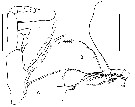 issued from : E.L. Markhaseva & Schulz in Proc. Zool. Inst. RAS, 2010, 314 (1). [p.21, Fig.12]. Female: A, Mxp (setation of endopod not given); B, Mxp (endopod). Scale bars 0.1 mm. Nota : Mxp : Syncoxa with 1 worm-like seta on proximal praecoxal endite, this element long, reaching middle length of basis ; 2 setae on middle endite, 1 short sclerotized and 1 worm-like of medium size and 3 setae on distal praecoxal endite, of these 2 short sclerotized and 1 long worm-like seta, exceeding middle length of basis ; coxal endite with 3 setae. Basis with 3 medial setae and 2 distal setae (belonging to endopod and incorporated into basis), 1 of distal setae sensory and worm-like ; endopod 5-segmented with 4, 4, 3, 3+1, and 3 sclerotized plus 1 worm-like sensory setae on distal segment.
|
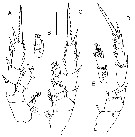 issued from : E.L. Markhaseva & Schulz in Proc. Zool. Inst. RAS, 2010, 314 (1). [p.22, Fig.13]. Female: A, P2 (anterior); B, P2 (endopod segment 2, posterior); C, P3 (posterior); D, P4 (right leg, coxa, basis, endopod segment 1 and exopod, posterior); FE, P4 (left leg, endopod segment 2-3). Scale bars 0.1 mm.
| | | | | NZ: | 1 | | |
|
Distribution map of Ranthaxus vermiformis by geographical zones
|
| | | | Loc: | | | Atlantic (00°01'S, 02°29'W) | | | | N: | 1 | | | | Lg.: | | | (1050) F: 1,2; {F: 1,2} | | | | Rem.: | above the sea bed (5058 m) | | | Last update : 30/07/2019 | |
|
|
 Any use of this site for a publication will be mentioned with the following reference : Any use of this site for a publication will be mentioned with the following reference :
Razouls C., Desreumaux N., Kouwenberg J. and de Bovée F., 2005-2025. - Biodiversity of Marine Planktonic Copepods (morphology, geographical distribution and biological data). Sorbonne University, CNRS. Available at http://copepodes.obs-banyuls.fr/en [Accessed October 24, 2025] © copyright 2005-2025 Sorbonne University, CNRS
|
|
 |
 |








